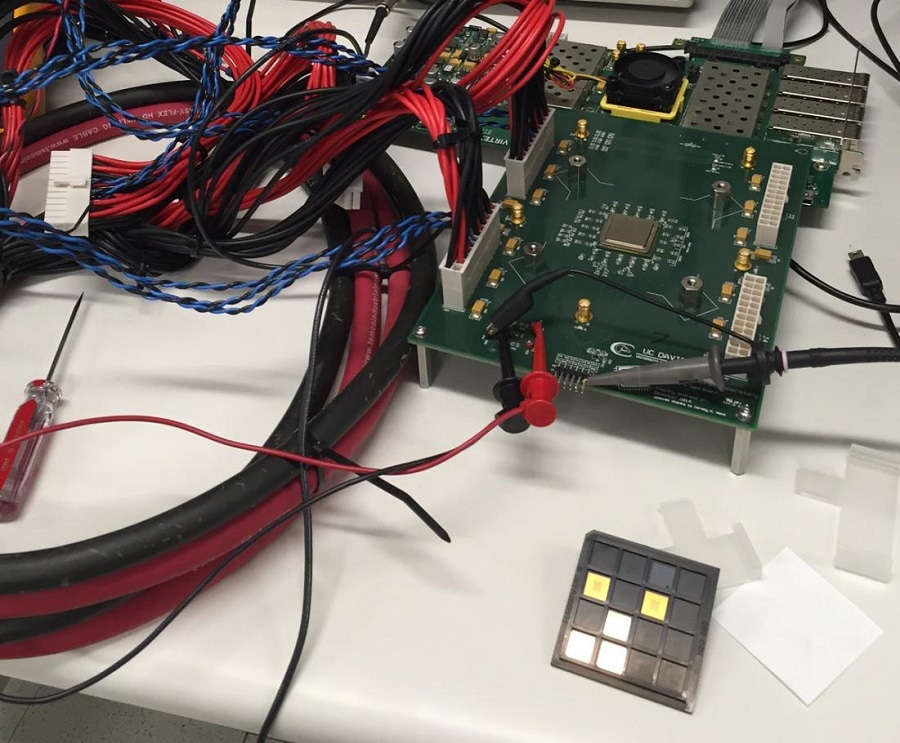Jun 20 2016
A research team from the Department of Electrical and Computer Engineering, at the University of California, Davis, have developed a microchip that consists of 1000 independent programmable processors. The chip called “KiloCore” contains a total of 621 million transistors. The highest computation rate of this energy-efficient microchip is 1.78 trillion commands per second. A report on this microchip was presented on June 16 at the 2016 Symposium on VLSI Technology and Circuits held in Honolulu.
 By splitting programs across a large number of processor cores, the KiloCore chip designed at UC Davis can run at high clock speeds with high energy efficiency. (Credit Andy Fell/UC Davis)
By splitting programs across a large number of processor cores, the KiloCore chip designed at UC Davis can run at high clock speeds with high energy efficiency. (Credit Andy Fell/UC Davis)
The team, that created the chip’s architectural design was headed by Bevan Baas, a professor of electrical and computer engineering.
To the best of our knowledge, it is the world’s first 1,000-processor chip and it is the highest clock-rate processor ever designed in a university.
Bevan Bass, Professor of Electrical and Computer Engineering, University of California
Based on the study conducted by Bass’s group, not more than 300 processors could be reached by any of the other multi-processor chips designed. Many of the other chips developed were created for the purpose of research while some were sold. IBM used their 32 nm CMOS technology to fabricate KiloCore.
Baas explains that each and every processor in the KiloCore runs its own, independent program. This method is different from the Single-Instruction-Multiple-Data methods used by GPUs. The basic concept behind this flexible method is to break an application into several smaller bits, where each individual bit can run simultaneously on varied processors, obtaining high throughput together with lower energy use.
The basic design of the chip was developed by Brent Bohnenstiehl, a graduate student. He says that each individual processor is timed independently and shuts down when it is not required, thus conserving energy. Instead of sharing a common memory area, which can lead to cramming of data, the cores directly transfer data to each other. The average maximum clock frequency of these cores is 1.78 GHz.
Baas commented that of all the “many-core” processors presented, KiloCore is most energy-efficient. As many as 115 billion commands can be executed in one second by the 1000 processors of KiloCore. The chip uses a mere 0.7 Watts, a unit so low that it can be powered by one AA battery. The instruction execution efficiency of the microchip is 100% more than the latest laptop processor.
Various applications have already been designed for KiloCore. These include applications that require great quantities of parallel data like datacenter record processing and scientific data applications and other applications such as encryption, video processing and wireless decoding/coding.
Automatic program mapping tools and a compiler have already been created by the research group for programming the microchip.
The other team members include graduates from UC Davis Aaron Stillmaker, Jon Pimentel, Timothy Andreas, Bin Liu, Anh Tran and Emmanuel Adeagbo. The design of the microchip was funded by the Department of Defense and ARL/ARO Grant W911NF-13-1-0090; with aid from NSF Grants 0903549, 1018972, 1321163, and CAREER Award 0546907; and SRC GRC Grants 1971 and 2321.